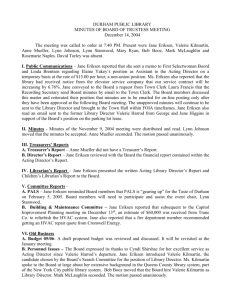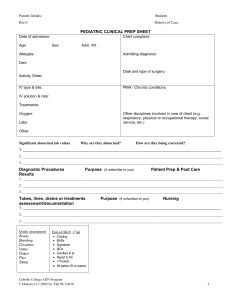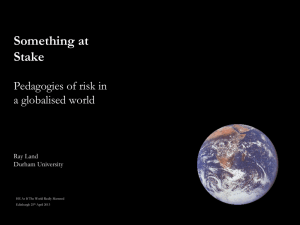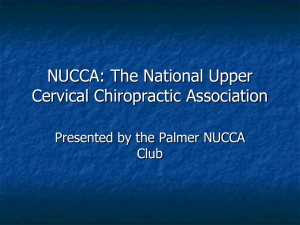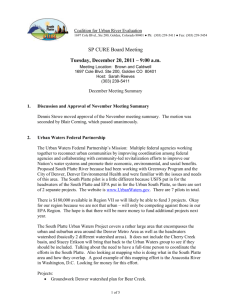Story of Norscot - Johannesburg Heritage Foundation
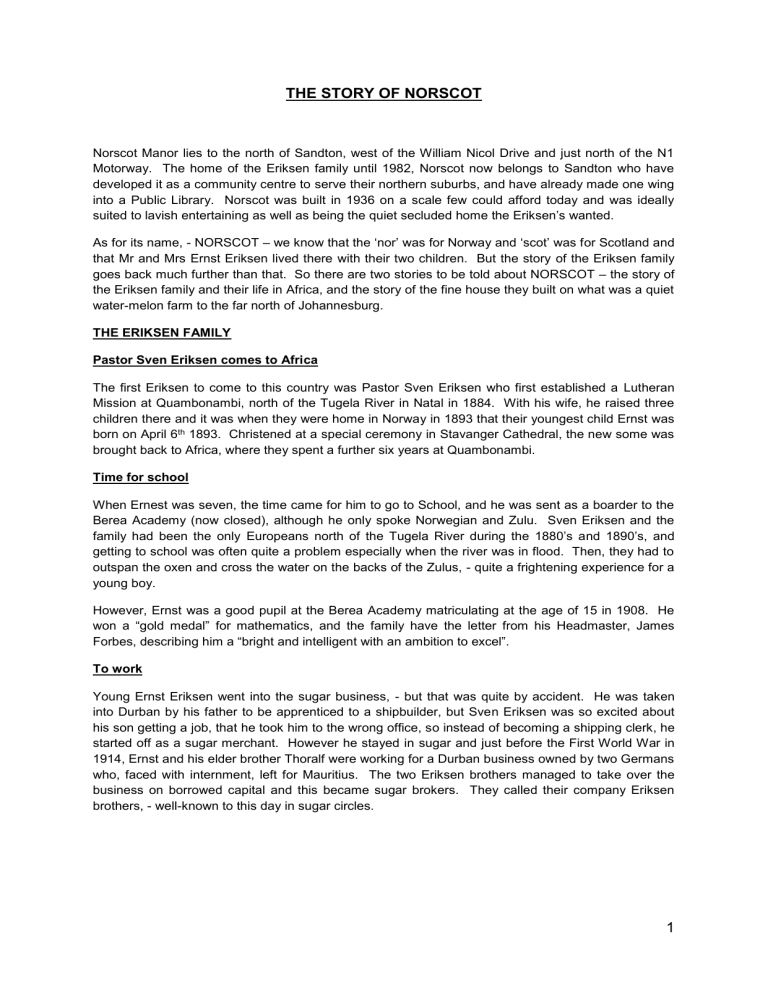
THE STORY OF NORSCOT
Norscot Manor lies to the north of Sandton, west of the William Nicol Drive and just north of the N1
Motorway. The home of the Eriksen family until 1982, Norscot now belongs to Sandton who have developed it as a community centre to serve their northern suburbs, and have already made one wing into a Public Library. Norscot was built in 1936 on a scale few could afford today and was ideally suited to lavish entertaining as well as being the quiet secluded home the Eriksen’s wanted.
As for its name, - NORSCOT – we know that the ‘nor’ was for Norway and ‘scot’ was for Scotland and that Mr and Mrs Ernst Eriksen lived there with their two children. But the story of the Eriksen family goes back much further than that. So there are two stories to be told about NORSCOT – the story of the Eriksen family and their life in Africa, and the story of the fine house they built on what was a quiet water-melon farm to the far north of Johannesburg.
THE ERIKSEN FAMILY
Pastor Sven Eriksen comes to Africa
The first Eriksen to come to this country was Pastor Sven Eriksen who first established a Lutheran
Mission at Quambonambi, north of the Tugela River in Natal in 1884. With his wife, he raised three children there and it was when they were home in Norway in 1893 that their youngest child Ernst was born on April 6 th 1893. Christened at a special ceremony in Stavanger Cathedral, the new some was brought back to Africa, where they spent a further six years at Quambonambi.
Time for school
When Ernest was seven, the time came for him to go to School, and he was sent as a boarder to the
Berea Academy (now closed), although he only spoke Norwegian and Zulu. Sven Eriksen and the family had been the only Europeans north of the Tugela River during the 1880’s and 1890’s, and getting to school was often quite a problem especially when the river was in flood. Then, they had to outspan the oxen and cross the water on the backs of the Zulus, - quite a frightening experience for a young boy.
However, Ernst was a good pupil at the Berea Academy matriculating at the age of 15 in 1908. He won a “gold medal” for mathematics, and the family have the letter from his Headmaster, James
Forbes, describing him a “bright and intelligent with an ambition to excel”.
To work
Young Ernst Eriksen went into the sugar business, - but that was quite by accident. He was taken into Durban by his father to be apprenticed to a shipbuilder, but Sven Eriksen was so excited about his son getting a job, that he took him to the wrong office, so instead of becoming a shipping clerk, he started off as a sugar merchant. However he stayed in sugar and just before the First World War in
1914, Ernst and his elder brother Thoralf were working for a Durban business owned by two Germans who, faced with internment, left for Mauritius. The two Eriksen brothers managed to take over the business on borrowed capital and this became sugar brokers. They called their company Eriksen brothers, - well-known to this day in sugar circles.
1
1914 – 1918 – The First World War
When the war broke out Ernst Eriksen, leaving his brother Thorald to run the business joined the
Second South African Horse Regiment as a trooper and served in the East African Campaign under
General Smuts and General Louis Botha. He progr essed well, was “Mentioned in Despatches”, and was commissioned in the field. Later in the war, he was among a contingent sent over to England to join forces in France, but when he got to England it was discovered that he was, in fact, Norwegian, and ther efore an ‘alien’ as he had never been naturalised. The authorities would not let him go to
France while his case was being discussed by the House of Lords, so they sent him on leave, which he spent playing golf in Scotland . His was apparently a ‘test’ case, and because of him, men of other nationalities were eventually allowed to command troops in the British Forces. Thus, in the Second
World War we saw the Free French, Poles and Norwegians who all played an important part in the campaign against the Germans. However, for Ernst Eriksen, the Armistice came, and he never went to France at all.
Golf in Scotland
The ‘golf leave’ in Scotland, however, turned out to be very important for Ernst Eriksen, because it was there that he met his future wife.
Ethel Mary Turner, daughter of the Manager of the Alisa Shipbuilding Yard at Troon, Ayrshire, on the west coast of Scotland. They met at the Royal Troon Golf Course, and subsequently became engaged. Ethel Turner had grown up in Ayrshire and had attended the Ayr Academy. She was an artistic girl and had distinguished herself by winning a sholarship to the London School of Art, ... an achievement she was unable to realise due to the outbreak of the First World War. However, her knowledge and artistic appreciation grew from the early beginnings and stood her in good stead much later when she was able to collect furniture and pieces of art for her family home in Johannesburg.
After a trip back to South Africa in 1918 to see how his buiness was progressing Ernst Eriksen returned to Scotland, where he and Ethel were married at Troon on December 30 th , 1919, returning to
Durban in early 1920. They travelled by Union Castle boat, settling in Natal where Ernst worked for some years as a sugar merchant. They lived in Durban where their son, Ernst Ronald Eriksen was born in 1921, and in 1926 moved to Kloof, where their daughter Joyce Turner Eriksen was born in
1927.
The Motor business
During the 1920’s motor cars had grown in popularity and had become of great interest to Ernst
Eriksen. He was invited to move with his family to Johannesburg to become Managing Director of a new motor firm to be know as Eriksen and Clothier, with premises at 22 Eloff Street. The company started as an Authorised Ford Dealer on August 1 st , 1933, and in 1935, when Ernst Eriksen became the sole proprietor, the name was changed to Eriksen Motors. The business grew, and by 1946,
Eriksen Motors became a Public Company uoted on the Johannesburg Stock Exchange, - a
Company of which Ernst Eriksen was both Chairman and Managing Director. Ernst Eriksen kept up his golf and served as Captain of the Royal Durban Golf Club as well as becoming President of the
Natal Golf Union and Vice-President of the South African Golf Union. In later years, he was an enthusiastic bowler and he inaugurated the Motor Industires Federation’s Annual Charity Day to raise funds for the Randjeslaagte Old Age Home shortly after the Second World War. He also presented a
Shield for Annual Competition between rinks from clubs affiliated to the Griqualand West Bowling
Association, and this event is still one of the highlights of the Kimberely Bowling Calendar.
Although Ernst Eriksen was not a technical man, he had great business ability and had been able to build up an extremely successful business. Thanks to his business acumen and its subsequent financial success, he was able to build a home to the very highest standards, using the best quality
2
materials as well as good designers. Eriksen Ford grew for twenty-five years under his able supervision, and its development is one of the great success stories of Johannesburg in the period following the Second World War.
First Johannesburg home
The first house the E riksen’s lived in Johannesburg had been the stables of what is now the Hope
Home in Westcliff. It was a stone house, designed by Sir Herbert Baker, and which they rented from the well-known South African authoress Sarah Gertrude Milne.
While there, they looked around for somewhere to build a permanent home. And it was while driving out to the north towards the mountains that they came across the water-melon farm belonging to
Chris van der Walt and is brother near what is today the Sandton suburb of Fourways. Thus it was that plans evolved for the building of the second Norscot (their house in Kloof, Natal, had also had that name).
THE BUILDING OF NORSCOTT
It was in 1935 when the Eriksen’s had first seen the land to the north of Johannesburg, and Ethel
Eriksen decided there and then that “this is where I want to build my home“. She had been captivated by the glorious open view to the north, with the land sloping away towards the Magaliesburg
Mountains, and by the superb sunset.
The very next day Ernst Eriksen set out to find out more about the land, and it was then that he met the van der Walt brothers. The land was part of the original farm of Witkoppen which had been proclaimed as long ago as 1856 and granted to Van Vuuren. By the 1900’s much of the original farm land had been in the hands of the van der Walt family for some years and, as mentioned before, was then being used as a water-melon farm, as well as for breeding Friesian cattle.
Ernst Eriksen introduced himself to the owners, and sat and had coffee with them, and before long he had persuaded them to sell 423 acres. Further acres were added at a later stage as they came up for sale, and “Norscot” eventually comprised 605 acres.
Needles to say, Ethel Eriksen was delighted, and work soon started on the first part of the project.
Ernst Eriksen lived in a tent at the site during the initial, and already “the Cottage” – comprising the two central wings with a courtyard joined by a fence and small central gate – was ready to move into by July 1936.
The original “Cottage” had been built by the builders Thomas Clarke, but all further work was carried out by Swiss master-craftsman Gottfired Heddinger over a period of ten years. Mr Heddinger lived in a flat at the property while supervising the work. First Class craftsman were employed, and everything possible was done to produce a building of the very highest possible standards. When the house was sold in 1982 it was described as having: “8 elegantly proportioned reception rooms designed for entertaining on a lavish scale. There are 6 bedrooms, 5 bathrooms and ample domestic offices. Total area under roof, excluding outbuildings 1,200sq. Metres.
Ernst Eriksen was an outgoing congenial man who loved entertaining, and his wife Ethel had very definite ideas about the style and the quality she wanted. The result was the ideal house, where receptions and parties were easy to handle ... and during its heyday Norscot saw many happy gatherings. The fine downstairs Tavern, which had been opened to celebrate Ernst Eriksen’s 50 th birthday on April 6 th , 1943, was much used as was the large “braai” area outside. Ernst Eriksen had always been keen on music, and liked to have a violinist on hand at his parties to serenade the ladies.
The house was always filled with people, especially sportsmen and politicians. Norscot was the expression of the personalities of both Ernst and Ethel and was well used. It should be remembered that through the 1950’s, Norscot was still very much a “country house”. Sandton and Randburg were
3
undeveloped, and the William Nicol Drive only came towards the end of the 1950’s. Access to
Norscot was still via Ferndale and Hendrik Verwoerd Drive, and the whole area around the house was still regarded by Johannesburg as being “out in the sticks”.
The Entrance and Hall
Access to Norscot used to be across the courtyard, where bright bougainvillea would twine around gum poles, and then through a shady porch into the spacious panelled reception hall. Today, the entrace is through what used to be the Sunroom. Or the Family Room, and into the loungeand hall from the west end.
Apart from its fine panelling, the Hall still retains it outstanding its outstanding feature, the elegant carved fireplace, which had come from the Parktown Home of Sir Julius Jeppe, one of Johannesburg
Landlords. The fireplace is still the main feature of what is today a gallery for some of WSSA’s art collections. The stained glass in other parts of the house (Billiard Room and Tavern) also came from the Julius Jeppe house when it was demolished. The glass was remodelled by Herbert Evans.
More fireplaces
Fireplaces are a great feature of Norscot , - there are eleven open ones many of them the flat raised type of Norwegian style. The stone fireplaces in the original dining room is of particular interest because the granite came from the nearby Norscott Kopie. This Koppie, now owned by the Sandton
Municipality as a Bird Sanctuary and Nature Reserve, was originally in two parts. The smaller section had been owned by a company called Waterman & Amery, and the larger part had belonged to a man called Mr James. Not much more is known about these original owners, but we do know that they were bought by Erns Eriksen and added to the Norscot Estate. Of sepecial note is an old tree near the reserve, a thorn Acasia Sieberana, which is around three hundered years old.
Another fireplace of special interest is the one in what used to be the Guest Wing, - now the Public
Library. The tiles surrounding it (made by Cullinans of Olifantsfontein) were brought out to commemorate the “Great Trek Centenary” in 1936 and include drawings of ox-wagons and other
“trek” subjects. There is also a find moulded fireplace in the west bedroom, which was Ethel Eriksen’s room, - from where she could see her fine sunsets and the glorious mountains.It is now to be called the “Troon” room.
Airbricks and moulding
Also of special note are the elegant “airbricks”, also made by Cullinans of Olifantsfontein. They are all moulded with open animal designs and are to be found in other houses of the period. The Viking Ship mouldings in the tavern downstairs, were also by Cullinans, as was the Norwegian Lions mouldings over the fireplace in the Master Bedroom to be called the “Stavanger” Room.
Lights
Fitted lights and lampshades add another interest to the house. First there are the wooden carved ones which came from Norway and then there are the glass enclosed ones in the sunroom. The bathroom light fittings are worthy of mention, being of art-deco styled glass and moulded into shell shapes. Fortunately, these have been retained as they blend so well with the period of the house.
Norscot woodwork
Visitors to the house should notice quality woodwork all supplied originally by Hunt, Leuchars and
Hepburn, the old established Mining Timber Company. Teak was used for all the windows and origan pine for the rafters. The floors were of panga-panga, a very hard wood that comes from Central
Africa. The detailed carving at Norscot such as the alcoves and the Viking Ship Bar in the downstairs
4
Tavern was all done by a craftsman carver, Mr Harcus. Who also did all the carving at “Libertas”, the official residence of the State President. Harcus came from the Hebrides and used to sit at work singing laments which should make Ethel Eriksen ask him if he could not sing some cheerful. He also carved fine replicas of the Scottish and Norwegian lions, and the South African coat of arms which were over the billiard room fireplace when the family was in residence. These carvings had been replaced by lights, and the originals are now in Mrs van Wyk’s Bryanston home as sentimental of her time at Norscot.
Wrought iron work
Specially made by the Rand Wrought Iron Works is the fine Juliet Balcony which is a feature of the main bedroom in the west wing. This was Ethel Eriksen’s bedroom, - now called the “Troon” room after the Scottish town of her birth. The stairway balcony and those in the “Tavern” is a replica of those in the Spanish Embassy in London.
Over the years, Ethel Eriksen had wide knowledge and experience of furniture, art and decoration, and during travels in many parts of the world, she built up an exceptional private collection. Her pewter collection was among the finest anywhere. Once, when they went to Hong Kong, her husband had to get crates specially built for her purchases, and another time when they were touring the
English countryside she bought a table which had to remain on her car roof for the rest of their trip until they got back to London. Ethel Eriksen, the house with her husband in mind, started collecting antiques in 1925 and had an extraordinary eye for quality. Norscot became, not only a home, where great parties and social gatherings took place (Ernst Eriksen was a congenial man and an excellent host) but also an ellegant residence, - the expression of a woman with fine taste backed by vast knowledge.
Ethel Eriksen flowers
Ethel Eriksen was a great asset to her husband in his business. She was not only an expert in the world of art and antiques, she also became an accomplished gardener. She had five acres of chrysanthemums at Norscot, and especially during the second World War, cut flowers and farm produce were sold to raise money for the Red Cross. Produce would be taken every Saturday morning to a morning market run by Mrs Lindberg (Mother Lindberg) of C.N.A connections, at her home now demolished, in Oxford Road, Parktown. Even after the war, charity sales continued, it was then that Mrs Eriksen sold her flowers, especially the chrysanthemums, to “Flower Design”. One special order for flowers designed was for the Ghana Government on the occasion of the opening of
Parliament in Accra by the Dutchess of Kent, then the Princess Marina, when Norscot chrysanthemums were sent to Ghana by air.
An interesting report-back came much later when Joyce Eriksen and her parents were travelling.
They met a naval officer who had been an aide-de-camp of Princess Marina, and he told them the flowers for the Parliament Opening had been magnificent. In 1943, the Eriksens sent Norscot flowers to their daughter in London for her 21 st Birthday at the Grosvenor House Hotel, - a nostalgic touch, and the forerunner of the great flower exporting business that has been developed by many companies and growers in South Africa aided by the faster and faster air delivery service. Another very memorable special arrangement of Norscot flowers was the display at the Rand Club in 1953 for the Coronation Ball, and another for an 1820 Settlers Ball at the City Hall, - both arranged and grown by Ethel Eriksen.
Ernst Eriksen farm
Apart from his business, Ernst Eriksen had another interest, ... in fact, another career, ... at which he excelled. This was his farm at Norscot, whihc he took very seriously, building up fine herds and running them most efficiently. He also divided his land into ‘camps’ where he grew himself much of
5
the fodder needed. Water was provided by boreholes, and stored in two large storage tanks in a building to the north of the main house. These tanks, with storage barn above, were covered with a shingled roof in keeping with the house so as not to spoil the view (see later paragraphs on “Norscot
Barn”)
At one stage there was as many as five hundred Buccaneers at Norscot, producing bacon for the
Escourt Bacon Factory and for which Ernst Eriksen won prizes at the Rand Agricultural Show. He also won prizes for some of his herd of one hundred and fifty Jersey cows, and in 1945 gained the
“Best Bull” award for a bull sold to Government of Rhodesia. He gained “Gold Medals” on four occasions for Best Lamb Carcasses at the Show (1953,1954, 1956 and 1962). There was also a flock of mutton sheep and later a herd of pedigree Herefords. All these awards could only be achieved by someone striving for perfection and working with great enthusiasm.
Following his father ’s footsteps
Ernst Ronald Eriksen, son of Ernst and Ethel Eriksen had gone to school at Cordwalles and later
Michael house, in in Natal, marticulating in 1937. He joined his father’s Company, at the bottom of the ladder, as a motor mechanic. In 1938 and then in 1939, the Second World War intervened and in
1940 Ronald joined the South African Navy as a Seaman and was commissioned in 1942. After the war, in 1945 he returned to the Motor Industry. He worked his way up, and was eventually appointed
Managing Director by his father who retained the position of Chairman himself until his death in 1964 at the age of seventy-one. Ronnie then took over from his father. He is in his own right, Fellow of the
Institute of the Motor Industry, serving three years as president of the Motor Industries Federation, from 1955 - 1958). He was Chairman of the Naval Officers’ Association, and in sport, has been primarily interested in circket. He served the Transvaal Cricket union as Manager if the Transvaal team, and is active in promo ting Schools’ Cricket. He has three sons and a daughter.
The Eriksen Company, Eriksen Consolidated Holdings, apart from its Headquarters in Central
Johannesburg, established many branches, all holding the Ford Franchise. Among these were
Kimbereley in 1946, Welkom in 1949, Vereeniging in 1949, and Vanderbijlpark in 1953. These were followed by Swaziland in 1955 and Sasolburg in 1956, and then Johannesburg North in 1965, Glen
Harmony in 1969 and Meyerton in 1979. The Company continued to prosper and grow, - so much so that when the famous Henry Ford II visited South Africa in 1984 he was able to attend a gathering of some fifteen long-service Ford Dealers, ... all with twenty-five or more years of service. Sold to the
Barlow Group in September 1984, the company, which has now been associated with the Ford Motor
Company for over fifty years, still has a large turnover.
Ernst and Ethels ’ Daughter: Joyce
Growing up in the wonderful open countryside around Norscot, Joyce Turner Eriksen attended
Kingsmead School in Rosebank, after which she took a diploma in Agriculture at Boschetto College in
Harrismith. She then ran the farm at Norscot for a while, describing herself as a “sort of land girl” during the Second World War. She then spent some time in England, returning later to South Africa.
She became very interested in politics, supporting the United Party, as did both her parents. For nine years, from 1962 – 1971, Joyce Eriksen did stalwart work as a Member of the Provincial Council in
Pretoria, as the United Party Representative for Hillbrow, until she got married and found that the demands of political and home life together were to great. She then gave up politics, but continued to support the United Party until it was later dissolved. Now Mrs Joyce van Wyk, she looks upon the time she spent in politics as having been years of great moment for South Africa, with leaders such as
Smuts and Villiers Graaf (Mrs Joyce van Wyk passed away in 1997).
6
Times change
In the meantime, it was becoming more and more difficult to maintain the Norscot property and the loyal staff were all reaching retirement stage. Mrs Ethel Eriksen survived her husband by fourteen years, and passed away at the age of 84 in 1978.
It was then that their daughter, now Mrs Joyce van Wyk, decided to sell the property.
One of the staff at the house, Philip Moyo, had been with the family for forty-five years, and then decided to return to his family in Zimbabwe, where he remains today. Philip had an exceptional record of service with the Eriksen family, having joined them in 1937. His father had been a Matabele
Chief (with eleven wife) in Plumtree, Zimbabwe, and many of the “little brothers” also worked at
Norscot. Philip Moyo is still in touch with the Eriksen family. Another helper at Norscot, George
Zikhali, who was Second Cook and in charge of Laundry, joined the staff in 1940 and completed fortyone and a half years with the family.
The NORSCOT “sale”
The sale at Norscot was quite the event in Johannesburg of 1982. With viewing on February 5 th , 6 th and 7 th and Auctions of the 8 th , 9 th and 10 th , it attracted over 3,300 people on the three days when over 3,000 items were offered for sale. It was described as the largest House Sale so far in the
Southern Hemisphere and the rich and the famous of South Africa were well represented, among them Mr Chiavelli, Gary Player and Barbara (then) Barnard.
Many spectacular items were on sale, including four Anton von Wouw bronzes, three early 19 th
Century view of Table Bay, two Frans Oeders, the moquette for John Tweeds statue of Cecil Rhodes and a rare Peter Wenning still life.
The Tweed moquette had belonged to Sir Abe Bailey and there was a stinkwood armoire which had belonged to Sir Lionel Philips at Vergelegen. Reminiscent of Ernst Eriksen himself there was on sale a rare 1964 Lincoln Continental 4-door convertible, which had been specially imported for the family.
The beautiful antique (1812) carved cradle which had been filled with flowers as a floral arrangement at the famous 1953 Rand Club Coronation Ball was also sold. Many of the rare items were retained by Mrs Van Wyk because of their sentimental associations.
The original farm, which had stretched as far as today ’s Fourways crossing, was split up, although a small portion was kept by Mrs van Wyk. Most of the land which was put up for sale was purchased by developers Schachat Cullum, and has become the new suburb of “Norscot Manor”. The house, with
11 hectares was finally sold to Sandton Council, following representations from many local organisation and ratepayers. The Fourways Ratepayers Association were strong in the encouragement to the Council and a Petition was arranged by the Sandton Historical Association asking for the property to be purchased for Sandton’s future benefit. During the time when the house had been empty and for sale, and under the auspices of the then Manyor, Clr Peter Bennett and his wife, a fine display of Sandton’s art treasures had been given for a week when there were also
Mayoral receptions and a musical evening. The historical Association also mounted an exhibition at the time, and it wa the use of Norscot which prompted much demand for the purchase of the house for civic purposes. The Sandton Foundation was also instrumental, in urging the Council to purchase, and in negotiating a feasible price.
Entrance and Gardens
The gardens were Ethel Eriksen’s pride and joy, where she grew her chrysanthemums and enjoyed the view. She had a rockery feature with a bridge over a stream which ran through gentle woodland.
All this has been restored and replanted, and helps to retain the tranquil atmosphere of the house.
The swimming pool always a popular attraction, was situated where there is now a circle for turning
7
outside the north gate. The palm trees growing there used to be around the pool. Now, they are extremely tall.
The original entrance was from William Nicol Drive to the eat, through an avenue of pines, and although this entrance is not now used, being part of another property, many of the trees are still there, creating a shady lane. A new and wider entrance has now been made on the far west side of the house giving access to a large parking area. To the north, where the land was sold and developed into the new suburb of “Norscot Manor”, a new road. Manor Close, leads up to the gate.
Nearby is also ‘Eriksen Close’ - a reminder of connections with the Eriksen family. There was originally a large dam and two smaller ones, where the houses in Manor Close stands today.
The original “Van der Walt” Cottage
Hidden away among the houses of Fourways, another house from the past has managed to survive.
Belonging originally to the two Van Der Walt brothers, from whom Ernst Eriksen had bought the property, the house had stood in around three hundred acres, but now stands on the corner of Ibis and Flamingo Roads. It still has some of its original flooring, and its tin roof. The lounge was 40 ft long.
The cottage had remained empty through the Second World War, but was final restored by Ernst
Eriksen when his son Ronnie returned from the Navy in the late 1940’s. After that, the house was let many times, and the house is remembered for its “famous” and “infamous” tenants who lived there.
There was Robert Tollast, a painter of portraits of some note who had worked for the British
Intelligence during the war. He spent ten years in South Africa, of which two were at the Norscot
Manor Cottage. Then there were Mr and Mrs Benger of Benger’s Foods.
The next tenant was the famous one, - Peter Prowse who was an actor and who put on his own show
“Diary of a Madman”. He became even more well-known because he eloped with a young girl while at the cottage, and was pursued around the country by police and newspaper reporters, - finally giving an interview from his “country estate” at Norscot.
The Cottage has yet another claim to fame in that Mr and Mrs Jack Pringle also lived there. Mrs
Pringles had previoulsy been Virginia Welles, wife of the famous Hollywood actor and producer Orson
Welles. Her daughter, Rebecca Welles, often visited them.
Mrs Joyce van Wyk herself laterally lived in the Cottage for a while with her family after her f ather’s death to be near her mother. The house has now been sold to Mr and Mrs Tom Morris.
“Norscot Barn’
Amongst the new houses of “Norscot Manor” stands a house which was moulded from the original water tanks, windmall and barn of the main Norscot house. It is difficult to believe that they were visible from the house, but the roof had been shingled to create an attractive appearance and so as not to spoil the view.
By the mid- 19 80’s, the roof was half of and the buildings was almost derelict with vagrants often camping inside it. The walls were covered with graphiti an removable frames missing. The property was purchased by Mr Ian Traill, who embarked on the most enterprising restoration task, and who has transformed a building that was completely run down into a most interesting and and exciting home.
The “windmill” ironwork has been left and included in the house, making a special feature of it in the hall. From the thick-walled water tanks, he cut bedrooms, and kitchen, lining the whole roof with woodwork , and spending hours on the detailed planning of the “new” house. One water tank remains
8
below the house as a workshop and garage. Now called “Norscot Barn”, No 57 Turaco Street is a joy to behold.
“Norscot” today
Norscot today is in full use, with classes meetings and social functions, weddings and business gatherings being held there with the Library giving a valuable service to the north-western areas of
Sandton. In spite of all the development that has gone on around the house, there is still a fine open view of the Magaliesburg Mountains and the sunsets are still a delight. It is most fitting the building which always echoed to the strains of music and enjoyment should still be used for pleasure, - for the benefit of the whole Sandton.
By Avril Reid
Acknowledgements:
Mrs Joyce van Wyk for her constant help and enthusiasm
The new Norscot Manor House Communicty Centre Committee
9
